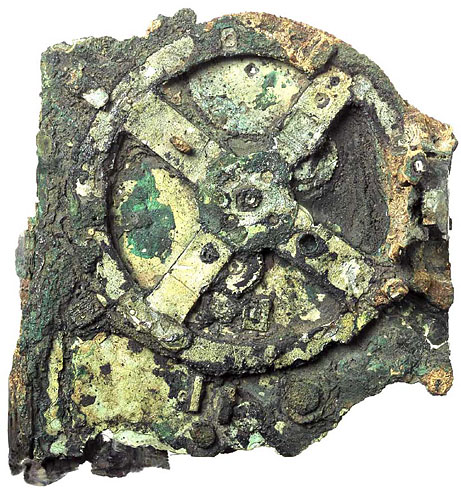|
|
|
|
Kil
Evil Skeptic

USA
13482 Posts |
 Posted - 12/10/2010 : 10:46:09 Posted - 12/10/2010 : 10:46:09






|
Remember the Antikythera mechanism?
The mechanism is the oldest known complex scientific calculator. It contains many gears, and is sometimes called the first known analog computer, although its flawless manufacturing suggests that it may have had a number of predecessors during the Hellenistic Period which have not yet been discovered. It appears to be constructed upon theories of astronomy and mathematics developed by Greek astronomers and it is estimated that it was made around 150-100 BC. One hypothesis is that the device was constructed at an academy founded by the ancient Stoic philosopher Posidonius on the Greek island of Rhodes, which at the time was known as a center of astronomy and mechanical engineering, and that perhaps the astronomer Hipparchus was the engineer who designed it since it contains a lunar mechanism which uses Hipparchus's theory for the motion of the Moon.
Investigators have suggested that the ship could have been carrying it to Rome, together with other treasure looted from the island to support a triumphal parade being staged by Julius Caesar. However, the most recent findings of The Antikythera Mechanism Research Project, as published in the July 30, 2008, edition of Nature also suggest that the concept for the mechanism originated in the colonies of Corinth, which might imply a connection with Archimedes. The circumstances under which it came to be on the cargo ship are unknown. Consensus among scholars is that the mechanism itself was made in the Greek speaking world. All the instructions of the mechanism are written in Greek… |

Antikythera mechanism
| …The device is remarkable for the level of miniaturization and for the complexity of its parts, which is comparable to that of 17th century clocks. It has over 30 gears, although Michael Wright (see below) has suggested as many as 72 gears, with teeth formed through equilateral triangles. When a date was entered via a crank (now lost), the mechanism calculated the position of the Sun, Moon, or other astronomical information such as the location of other planets. Since the purpose was to position astronomical bodies with respect to the celestial sphere, with reference to the observer's position on the surface of the Earth, the device was based on the geocentric model… |
Well Lego fans, what have you been waiting for? Yes indeed, is there nothing that can’t be built using Legos?
Antikythera mechanism: An eclipse-predicting machine made of Legos
| Most of us probably aspire to build nothing more complex this year than a gingerbread house. (Tick tock.) Videographer John Pavlus spent much of 2010 writing and shooting a video about an Apple engineer, Andy Carol, who designed and built a fully functional eclipse-predicting machine, a replica of an ancient Greek device, out of 1,500 Lego Technic parts and 110 gears. It's so fun that I watched the video, commissioned by Nature Publishing Group's video group (Scientific American is part of Nature Publishing Group and Pavlus used to work for Scientific American—bazinga!) a few times without even realizing I was looping… |

See the video!!!
Dave! Get to it!!!
|
Uncertainty may make you uncomfortable. Certainty makes you ridiculous.
Why not question something for a change?
Genetic Literacy Project |
|
|
Badger
Skeptic Friend

Canada
257 Posts |
 Posted - 12/10/2010 : 13:23:24 [Permalink] Posted - 12/10/2010 : 13:23:24 [Permalink]



|
That, right there, is sublime!
Lego's and archaeology! |
If you think it's work, you're doing it wrong. |
 |
|
|
 |
|
|
|
![]()